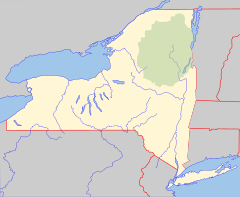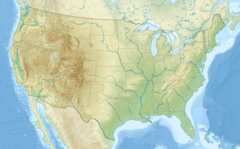Fulmer Creek facts for kids
Quick facts for kids Fulmer Creek |
|
|---|---|
|
Location of mouth within New York
|
|
| Country | United States |
| State | New York |
| Region | Central New York |
| County | Herkimer |
| Town | German Flatts |
| Physical characteristics | |
| Main source | NW of Paines Hollow 1,302 ft (397 m) 42°59′06″N 74°54′50″W / 42.985071°N 74.9137639°W |
| River mouth | Mohawk River / Erie Canal Mohawk 384 ft (117 m) 43°00′56″N 75°00′46″W / 43.0156259°N 75.0126563°W |
| Length | 11.5 mi (18.5 km) |
| Basin features | |
| Basin size | 26.2 sq mi (68 km2) |
| Tributaries |
|
Fulmer Creek is a river about 11.5-mile-long (18.5 km) in New York. It flows into the Mohawk River in a place called Mohawk, New York. The creek got its name from the "Fulmer" family. They were part of the Tryon County militia and bought land in the area a long time ago.
The area of land that drains into Fulmer Creek is called its watershed. This watershed is about 26.2-square-mile (68 km2). It makes up a small part of the larger Mohawk River watershed.
Contents
The Journey of Fulmer Creek
Fulmer Creek starts near Oregon Road and Decker Road on Shoemaker Hill. This is northwest of Paines Hollow. It then flows southwest, going under Shoemaker Hill Road.
Soon, it passes under State Route 168. Here, it meets Rightman Creek. The creek then turns west. It continues and goes under State Route 168 two more times.
Next, it meets Day Creek from the south. This happens as it flows through the small town of Days Rock. The creek then turns northwest. It crosses under State Route 168 again.
After that, it meets Flat Creek from the south. It keeps going and soon meets Ford Creek. Then, it crosses under State Route 168 three more times.
Now, on the south side of State Route 168, it meets Trout Creek. Soon after, it passes under State Route 28. This is where it enters the village of Mohawk.
In Mohawk village, the creek meets Hungry Hill Creek from the east. Fulmer Creek flows through the village. It goes under West Main Street and then State Route 5S. Finally, it joins the Mohawk River and the Erie Canal.
A Look Back: History of Fulmer Creek
Long ago, pioneers built a bridge and a mill on Fulmer Creek. But these were destroyed during attacks. On November 12, 1757, a French-Indian raid led by de Belletre burned them down. Many farmhouses in the area were also burned. This happened again in April 1758.
The buildings were rebuilt, but then destroyed again. This happened during the Revolutionary War raids in 1778 and 1782. The area around Fulmer Creek has seen a lot of history!
Understanding the Fulmer Creek Watershed
The land area that drains into Fulmer Creek is called its watershed. About 54 percent of this area is covered by forests. The rest is a mix of homes and farms in the upper parts of the creek. In the lower part, near Mohawk village, it's mostly homes and businesses.
The creek slopes downwards along its path. It has a steep section in the middle. This slope helps the water flow.
Water Science: Hydrology of Fulmer Creek
Measuring Water Flow: Discharge
The United States Geological Survey (USGS) keeps an eye on Fulmer Creek. They have a special tool called a stream gauge. This gauge measures how much water flows in the creek. It has been working since August 2014.
The gauge is located about 2.7 miles (4.3 km) upstream from where the creek meets the Mohawk River. The most water ever measured was 1,450 cubic feet (41 m3) per second. This happened on June 6, 2017. The least amount of water was .56 cubic feet (0.016 m3) per second on September 7, 2016.
In August and September 2011, there was a very big flood. The water level reached about 14.6 feet (4.5 m). On average, during summer, about 20 cubic feet (0.57 m3) per second of water flows in the creek.
Checking Water Quality
The NYSDEC (New York State Department of Environmental Conservation) studied Fulmer Creek's water in 2005 and 2006. They found that the water was mostly healthy. It was good enough to support life in the creek.
The DEC says the water quality is Class C. This means it's good for fishing and for people to play in, as long as they don't touch the water directly. They also added a "(T)" to the rating. This means the water is suitable for trout fish to live in.
Keeping Floods Away: Flood Control
Fulmer Creek has had big floods since 1889. Many floods happen because of ice jams. This is when ice breaks up in the creek, piles up, and blocks the water flow. This usually happens from late December through spring.
Before 1963, the Main Street bridge in Mohawk was a common spot for ice jams. They made this bridge taller and wider. This helped reduce the risk of ice jams.
Sometimes, gravel and dirt build up in the creek. This makes the creek shallower and can cause floods. A serious ice jam in 1971 caused a big flood. The flood on August 31, 1950, was one of the biggest. The water flow was about 3,250 cubic feet (92 m3) per second.
If the Mohawk River itself is flooding, water can flow backward into Fulmer Creek. This can cause floods in the lower parts of Mohawk village.
In 1998, experts started looking for ways to stop flooding. They studied the creek and found that much of the dirt came from eroding banks. This dirt then settled, making the creek shallower and more likely to flood.
In 2013, after major floods, a new study was done. It looked at Fulmer Creek and other nearby creeks. They found that many steep slopes were sliding. This added a lot of dirt to the creek. The study also found three main areas where floods were a big problem.
One problem area was near where State Route 168 crosses the creek twice. A large part of the creek bank was falling apart. This was about 550-foot-long (170 m) and 220-foot-high (67 m). This falling bank added a lot of dirt to the creek. Work started here in 2020. They moved the creek away from the bank. They also added lots of big rocks and planted willow trees. This helps stop the bank from falling apart.
Another problem area was from Leatherstocking Trailer Park to State Route 28. In the 2013 flood, many trailers were damaged or destroyed here. This area also had a big bank failure. This bank was about 300-foot-long (91 m) and 140-foot-high (43 m). Fixing this area was important to protect the nearby highway ramp.
The third problem area was from Devendorf Street to West Main Street. Here, too much dirt had built up. This made it hard for water to flow. Houses on Firman Street and the Mohawk Central Valley School had been flooded before. After the 2013 flood, they dug out some of the dirt. In 2019, a big project started to rebuild this section. It cost $1.4 million and helped prevent future floods.



